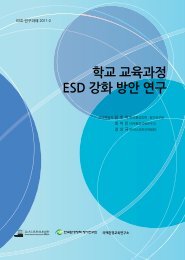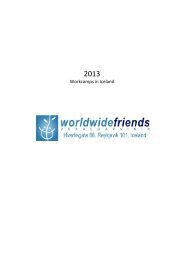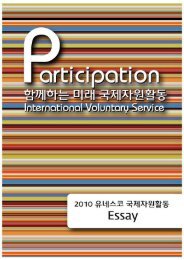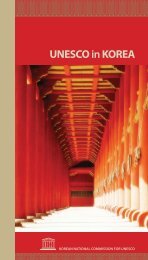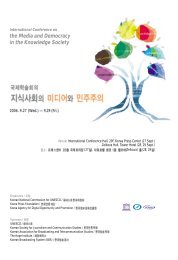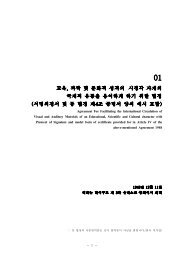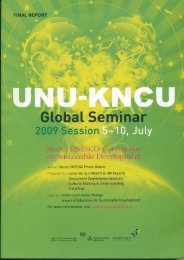íëìë³´ë2012문íì ë°ì ë¼ì´ëí ì´ë¸.pdf - ì ë¤ì¤ì½íêµììí
íëìë³´ë2012문íì ë°ì ë¼ì´ëí ì´ë¸.pdf - ì ë¤ì¤ì½íêµììí
íëìë³´ë2012문íì ë°ì ë¼ì´ëí ì´ë¸.pdf - ì ë¤ì¤ì½íêµììí
Create successful ePaper yourself
Turn your PDF publications into a flip-book with our unique Google optimized e-Paper software.
competent through a higher status and education, and jobs have been created. In this process,<br />
relatedness among community members saw an increase, boosting social capital that<br />
eventually helps achieve social and economic development.<br />
The economic role of relatedness among members of a common culture has been discussed<br />
in several studies. Karlan and Appel (2011) studied the relationship between loan repayment<br />
and social solidarity using the “microcredit group loan” system run by a Peruvian branch of<br />
FINCA, a credit bank. Whereas most microcredit financial institutions granted loans to<br />
customers who came in groups, FINCA made a list of customers in order of their visit and<br />
formed groups at random. Social solidarity was then studied in two ways. One was using a<br />
cultural index. Solidarity was defined using languages or clothing of individuals as<br />
continuous variables. The other concerned geographical solidarity measured by the ratio of<br />
people living in towns that were a 10 minute walk apart. This research studied 600 borrowers<br />
for two years and found that groups with high cultural and geographical solidarity tended to<br />
repay loans in time and showed a low probability of deviating from the group, whereas<br />
groups with strong internal solidarity tended to better forgive people who could not repay<br />
loans (Karlan et al., 2012: 190-191). This means that groups with strong relatedness among<br />
members - i.e., groups with high social capital - can manage each other more effectively.<br />
Another case often cited as a prime example of social capital enhancement through culture<br />
and arts is El Sistema of Venezuela. El Sistema, a youth music education program, is one of<br />
the most widely known cultural welfare programs today. Created by economist, social activist,<br />
and amateur musician Dr. Abreu in 1975, the program has grown into an organization with<br />
190 centers with 260,000 members in total. El Sistema was created by Dr. Antonio who<br />
wanted to get children from poor families to hold musical instruments instead of guns in a<br />
country where crimes are rampant. The program started with 11 members at a garage in a<br />
slum, but with growing sponsorship from other governments and private companies, it has<br />
grown to the extent that it influences countries all around the world.<br />
What differentiates El Sistema from existing music education programs is that it pursues<br />
social change. The program not only contributes to crime prevention by teaching music to<br />
children in slums who are exposed to a variety of dangers such as drugs, violence,<br />
pornography, and gun accidents, but it also helps give children hope, a sense of belonging,<br />
and a goal, all the while teaching them the values of dreams, cooperation, empathy, order,<br />
and responsibility. Social capital played a key role in the success of El Sistema by integrating



